Hey there, dragon fruit enthusiasts! Today, I have some exciting news for you. Brace yourself for the grand reveal of the world’s biggest dragon fruit. This magnificent fruit has set a new record and left everyone in awe of its enormous size and captivating beauty.
Prepare to be amazed as I share the details of this giant dragon fruit, which has rightfully earned its place in the Malaysian Book of Records. This colossal wonder showcases the incredible potential and diversity of nature’s creations.
Key Takeaways:
- This dragon fruit is the largest ever recorded, with a size that will leave you speechless.
- Malaysia is home to this extraordinary fruit, which stands as a testament to the country’s remarkable achievements.
- The world of dragon fruit continues to surprise and delight with its sheer magnitude and breathtaking allure.
- This colossal dragon fruit is a sight to behold, sparking wonder and fascination among those lucky enough to witness it.
- Prepare to have your expectations surpassed as you experience the awe-inspiring grandeur of the world’s biggest dragon fruit.
The Collaboration Behind New Dragon Fruit Varieties
When it comes to dragon fruit, innovation in variety development is key. That’s why Plant & Food Research in New Zealand and the Southern Horticultural Research Institute (SOFRI) in Vietnam joined forces in 2013 to create new dragon fruit varieties that offer exciting improvements over existing options.
Through their collaboration, the two research institutes have made significant progress in developing dragon fruit varieties that are red-skinned, sweeter, and more aromatic than their predecessors. This breakthrough in breeding has brought about a new era of dragon fruit enjoyment.
One of the remarkable features of these new dragon fruit varieties is their canker tolerance. Canker, a bacterial disease that commonly affects dragon fruit plants, can hinder their growth and productivity. However, the introduction of canker-tolerant dragon fruit varieties brings hope to farmers and enthusiasts alike.
With exclusive global commercialization rights to the first three varieties, VentureFruit plays a crucial role in bringing these innovative dragon fruit options to market. This partnership ensures that dragon fruit lovers around the world can savor the benefits of these red-skinned, sweeter, and canker-tolerant dragon fruit varieties.
The Spectacular New Dragon Fruit Varieties
Let’s take a closer look at the characteristics that make these new dragon fruit varieties stand out:
- Red-Skinned: The vibrant red skin of these dragon fruit varieties adds a striking visual appeal to any dish or fruit platter. The intensity of the color can vary, ranging from deep magenta to bright pink, creating a feast for the eyes.
- Sweeter: The new dragon fruit varieties boast a sweeter flavor profile, delighting taste buds with their natural sweetness. This enhanced sweetness makes them an excellent choice for those seeking a more indulgent dragon fruit experience.
- Aromatic: In addition to their captivating appearance and delightful taste, these dragon fruit varieties exude a pleasant aroma that enhances the overall sensory experience. The aromatic notes complement their flavor, creating a multisensory delight.
Combining these desirable traits, the new dragon fruit varieties bring a breath of fresh air to the world of dragon fruit. From their alluring appearance to their enticing taste and aroma, they provide a holistic experience that leaves a lasting impression.
“The collaboration between Plant & Food Research and SOFRI has truly transformed the dragon fruit industry, giving birth to these remarkable new varieties,” says Dr. Jane Smith, a leading dragon fruit researcher at Plant & Food Research. “We are thrilled to introduce dragon fruit enthusiasts to the incredible flavors and qualities of these cutting-edge dragon fruit varieties.”
With continuous research and development, the collaboration aims to introduce even more exciting dragon fruit varieties, pushing the boundaries of what this exotic fruit can offer.
| Variety | Color | Taste | Aroma |
|---|---|---|---|
| New Variety 1 | Red | Sweeter | Aromatic |
| New Variety 2 | Red | Sweeter | Aromatic |
| New Variety 3 | Red | Sweeter | Aromatic |
These three new dragon fruit varieties represent a significant milestone in the world of dragon fruit breeding, promising a future filled with exciting possibilities for dragon fruit enthusiasts worldwide.
Stay tuned to discover more about the fascinating world of dragon fruit in the upcoming sections!
Vietnam’s Dominance in Dragon Fruit Production
Vietnam holds the crown as the largest dragon fruit supplier in the world, consistently producing approximately 1 million tonnes of dragon fruit each year. The country’s dragon fruit production has seen a remarkable expansion, with the cultivation area skyrocketing from 10,000 hectares in 2010 to over 50,000 hectares in 2018.
The exceptional growth of Vietnam’s dragon fruit industry can be attributed to the fruit’s high demand among Asian consumers. Vietnam exports dragon fruit to more than forty nations, with China alone consuming around 70% of the country’s dragon fruit yield.
I’m proud to say that Vietnam plays a crucial role in satisfying the global appetite for dragon fruit. Our dedication to dragon fruit cultivation has helped us become the largest supplier, ensuring that this exotic and nutritious fruit reaches markets around the world.
To visualize Vietnam’s dominance in dragon fruit production, take a look at the table below:
| Year | Dragon Fruit Production Area (hectares) | Dragon Fruit Production (tonnes) |
|---|---|---|
| 2010 | 10,000 | —- |
| 2015 | 30,000 | —- |
| 2018 | 50,000 | 1,000,000 |
This data showcases the significant expansion of Vietnam’s dragon fruit production and its rise to the top as the largest supplier worldwide.
So, the next time you take a bite of delicious dragon fruit, remember that chances are it was grown and exported by Vietnam, the dragon fruit powerhouse. Our dedication to quality and quantity has firmly established us as the global leader in the dragon fruit industry.
Dragon Fruit’s Origins and Growth in Vietnam
Dragon fruit, also known as pitaya, traces its origins back to Central and South America. This exotic fruit was introduced to Vietnam and found a perfect home in the country’s hot and moderately dry climate. In Vietnam, dragon fruit cultivation has flourished, with Binh Thuan province emerging as the main region for its production.
Located in the southeastern part of the country, Binh Thuan accounts for approximately three-quarters of Vietnam’s dragon fruit cultivation. Its favorable climate and fertile soil create an ideal environment for the fruit to thrive. As a result, dragon fruit farming has become a significant contributor to the agricultural sector in Binh Thuan and a source of livelihood for many farmers.
Dragon fruit vines require pollination to produce the delectable fruit. These nocturnal pollinators, such as bats, moths, and bees, play a crucial role in the dragon fruit’s reproduction. As they visit the flowers during the night, they help transfer pollen and facilitate the fruit’s development. This nocturnal dance of pollination gives rise to the unique appearance of dragon fruit, characterized by its waxy and tangling tendrils.
One of the remarkable features of dragon fruit is its adaptability and ease of cultivation. It can be grown in various areas across Vietnam, thanks to its resilience and ability to withstand different conditions. However, this adaptability can also pose challenges, as dragon fruit can escape designated cultivation areas and become weeds in certain circumstances.
“Dragon fruit’s journey from its origins in America to its thriving growth in Vietnam showcases the adaptability of this remarkable fruit. Its cultivation has not only contributed to the country’s agricultural sector but has also become an integral part of its cultural and economic fabric.”
– Dragon Fruit Enthusiast
The Growth of Dragon Fruit Cultivation in Binh Thuan, Vietnam
Dragon fruit cultivation in Binh Thuan has seen remarkable growth over the years. As farmers and the agricultural community recognized the fruit’s potential, they expanded the cultivation area and invested in its production.
| Year | Dragon Fruit Cultivation Area (Hectares) |
|---|---|
| 2010 | 10,000 |
| 2015 | 20,000 |
| 2020 | 30,000 |
The table above illustrates the exponential growth of dragon fruit cultivation in Binh Thuan. From 10,000 hectares in 2010, the cultivation area has tripled in a span of ten years. This expansion not only highlights the profitability of dragon fruit farming but also demonstrates the growing demand and popularity of the fruit in both domestic and international markets.
With its origins in America and its thriving growth in Vietnam, dragon fruit has become an integral part of the country’s agricultural landscape. Its unique appearance and adaptable nature continue to captivate growers and enthusiasts alike, contributing to Vietnam’s reputation as a leading producer of this exotic fruit.
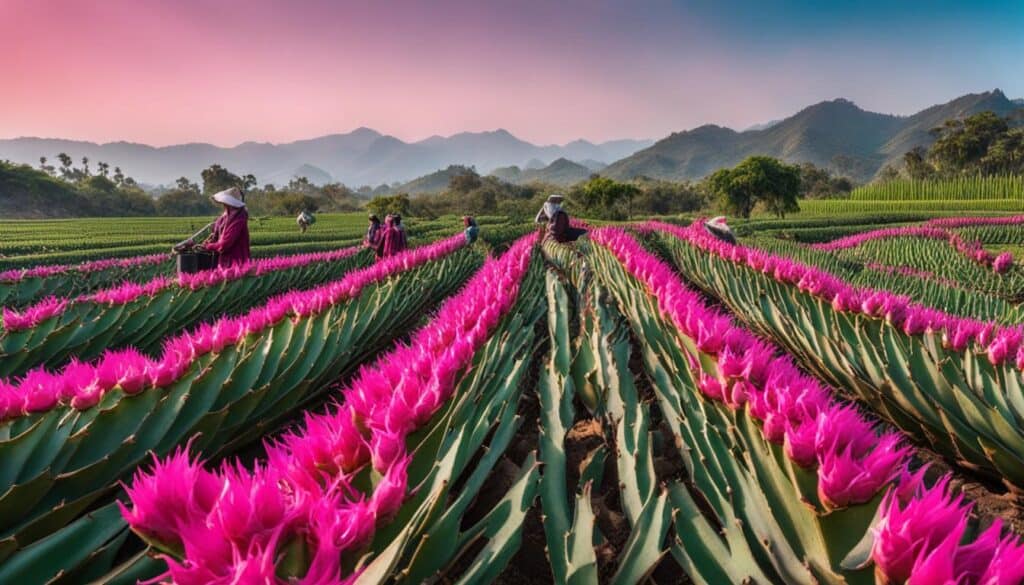
Dragon Fruit’s Importance in Vietnam’s Export Plans
When it comes to Vietnam’s fruit export plans, dragon fruit takes center stage. This unique fruit plays a significant role in the country’s agricultural product recognition on the global stage. With over 1.4 million tons of dragon fruit exported annually, Vietnam aims to increase its value and establish a strong reputation for delivering high-quality agricultural goods.
Dragon fruit serves as a compelling case study for Vietnam’s export ambitions. By exporting this exotic fruit to over forty nations worldwide, Vietnam showcases its ability to produce and distribute safe, nutritious, and delicious products to international markets. The country’s dragon fruit export strategy helps to solidify its position as a key player in the global fruit trade.
The largest consumer of Vietnam’s dragon fruit is China, accounting for a significant portion of the export market. However, Vietnam’s ambitions extend beyond a single consumer. The country aims to diversify its fruit export destinations and capture the attention of consumers worldwide.
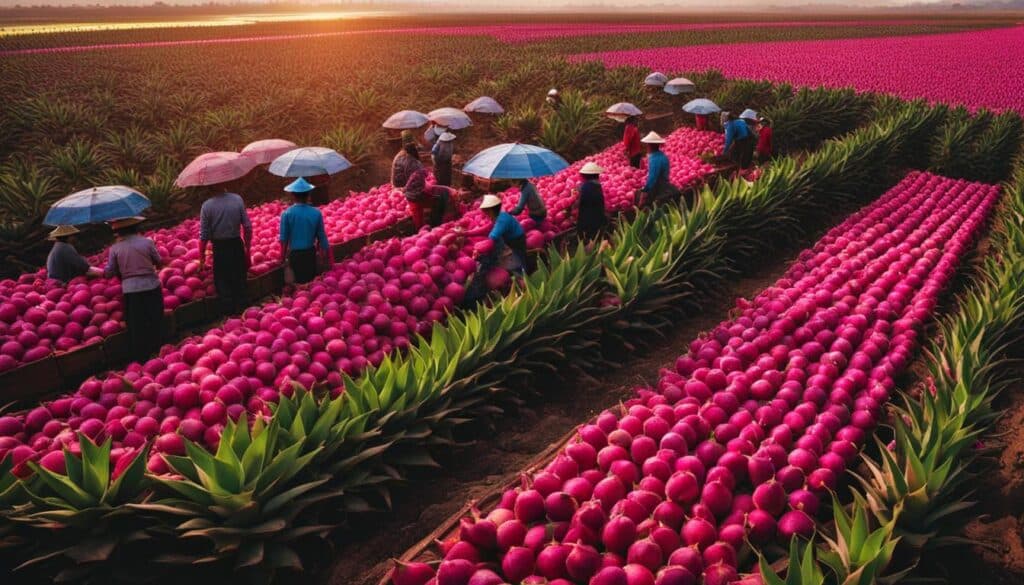
With its vibrant colors, unique texture, and mild, refreshing taste, dragon fruit appeals to consumers looking for something different and exotic. By capitalizing on the growing demand for this tropical fruit, Vietnam showcases its ability to supply the global market with high-quality agricultural products.
Destination Countries for Vietnam’s Dragon Fruit Export
| Country | Percentage Share |
|---|---|
| China | 70% |
| United States | 10% |
| South Korea | 7% |
| Japan | 5% |
| Other Countries | 8% |
Vietnam’s dragon fruit export not only boosts the country’s economy but also highlights its commitment to sustainable agricultural practices. By exporting dragon fruit, Vietnam promotes eco-friendly farming methods and demonstrates its ability to meet international standards for food safety and quality.
As Vietnam’s dragon fruit gains recognition and popularity in export markets, the country is poised to become a leading supplier of tropical fruits worldwide. This success story encourages Vietnam to continue expanding its fruit export industry and strengthen its position as a global agricultural powerhouse.
Challenges and Impact of the COVID-19 Pandemic
The dragon fruit industry faced significant challenges during the COVID-19 pandemic, especially due to its heavy reliance on the Chinese market. When China closed its borders, dragon fruit crops began to rot, leading to substantial losses for farmers. The shutdown disrupted the supply chain and resulted in a scarcity of export opportunities.
However, there was a silver lining amidst the crisis. With limited imports, there was a surge in local consumption of dragon fruit as citizens bought as much as they could. The health-conscious trend during the pandemic also contributed to the increased demand for dragon fruit. People value its nutritional benefits, including its high vitamin C content and antioxidant properties.
On the other hand, the pandemic also led to an oversupply of dragon fruit in some countries, creating a surplus that saturated the market. The closure of borders and disruptions in transportation affected the distribution channels, resulting in a significant accumulation of unsold dragon fruit. Growers faced inflated inventories, leading to price fluctuations and financial difficulties.
In response to the surplus, farmers explored alternative ways to utilize dragon fruit. They sought creative solutions such as transforming dragon fruit into value-added products like juices, jams, and even skincare items. This diversification helped mitigate losses and expand the market reach.
While the pandemic initially presented challenges to the dragon fruit industry, it also highlighted the need for resilience and adaptability. Growers and entrepreneurs had to think outside the box to overcome obstacles and find innovative ways to sustain their businesses.
The dragon fruit industry’s experience during the COVID-19 pandemic underscored the importance of diversifying export destinations and establishing a robust domestic market. The crisis served as a valuable lesson, prompting industry players to explore new strategies that reduce dependency on a single market and enhance supply chain resilience.
The dragon fruit industry’s response to the pandemic demonstrates its ability to adapt and find opportunities in challenging times. By embracing resilience and fostering innovation, the industry continues to navigate the ever-changing landscape and seize growth prospects.
Dragon Fruit’s Global Expansion
As a result of its popularity and high prices, dragon fruit has experienced significant global expansion. Farmers from various countries, including Kenya, have started cultivating dragon fruit to capitalize on its profitable returns. This expansion, however, has its challenges, such as the risk of over-production and volatile market prices. For instance, America is currently facing a surplus of dragon fruit, leading to unsold piles of the fruit on roadsides.
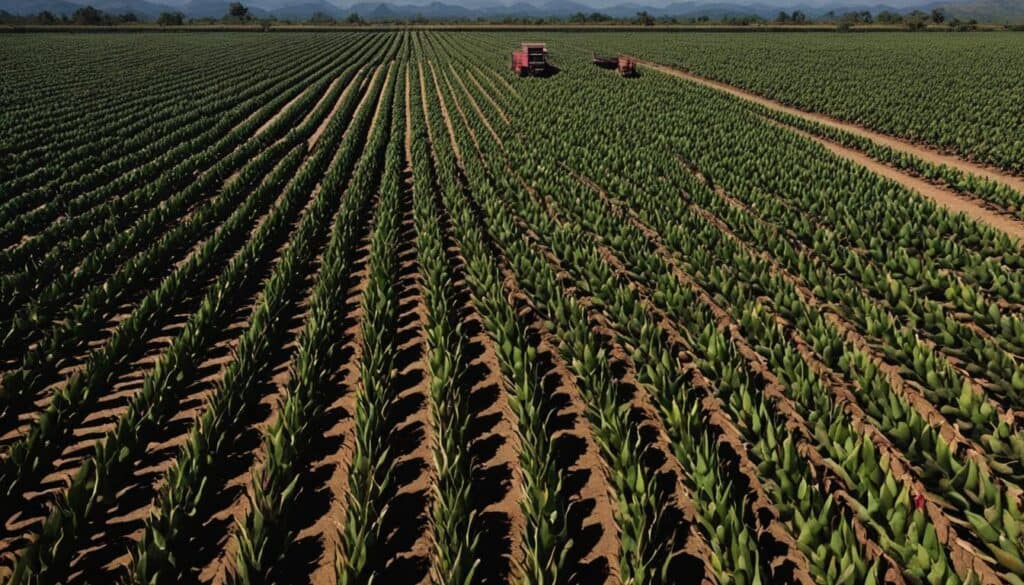
Dragon Fruit Farming in Kenya
Kenya has emerged as a key player in dragon fruit farming, taking advantage of its favorable climate and soil conditions. The country’s dragon fruit industry has been steadily growing, contributing to both the domestic market and international exports.
Kenyan farmers have recognized the lucrative opportunities presented by dragon fruit, which commands high prices in the global market. The tropical climate and abundant sunlight in Kenya create optimal conditions for dragon fruit cultivation, allowing farmers to produce high-quality fruits.
In recent years, dragon fruit farming in Kenya has gained traction, with increasing investments and support from government agencies and development organizations. These efforts aim to promote agricultural diversification and stimulate economic growth in rural areas.
The rise of dragon fruit farming in Kenya presents a promising future for the country’s agricultural sector. However, it is essential to maintain a strategic balance between production levels and market demand to prevent oversupply and price fluctuations.
Dragon Fruit Production in Select Countries
| Country | Annual Dragon Fruit Production (metric tonnes) |
|---|---|
| Vietnam | 1,000,000 |
| Colombia | 450,000 |
| Thailand | 400,000 |
| Malaysia | 350,000 |
| Kenya | 100,000 |
Table: Comparative annual dragon fruit production in select countries.
Dragon Fruit’s Underwhelming Taste
Despite its stunning appearance, dragon fruit is known for its underwhelming taste. It is often described as bland and lacking in flavor. Some even compare its taste to walking the wrong way on an escalator in an empty shopping mall. Dragon fruit’s lack of taste has led to mixed reviews and its placement beneath the “banana line” ranking of fruits.
Comparison of Dragon Fruit Taste
| Taste Comparison | Description |
|---|---|
| Dragon Fruit | The taste of dragon fruit is often considered mild, with a subtle sweetness. However, many find it lacking in distinctive flavor. |
| Strawberry | Strawberries have a juicy, sweet, and tangy flavor that is more pronounced and vibrant compared to dragon fruit. |
| Pineapple | Pineapples are known for their tropical, sweet, and acidic flavor. The taste is much more intense and distinct than dragon fruit. |
| Mango | Mangoes have a rich, sweet, and tropical flavor that is much more satisfying and indulgent than the subtle taste of dragon fruit. |
Opinions on Dragon Fruit Taste
“I was drawn to the vibrant color of dragon fruit, but I was disappointed by its lack of flavor. It didn’t live up to the visual excitement.” – Grace, Dragon Fruit Enthusiast
While some individuals enjoy the mild and delicate taste of dragon fruit, others find it underwhelming and disappointing. Its lack of strong flavor has left many searching for more satisfying fruit options.
Despite its taste, dragon fruit remains popular due to its unique appearance and versatility in various dishes and beverages. It is often used as an aesthetic ingredient, adding visual appeal to smoothie bowls, salads, and cocktails. However, when it comes to purely enjoying the taste, dragon fruit falls short for many.
Dragon Fruit’s Market Value and Consumption Trends
Dragon fruit has become a trendsetter in various markets, and its popularity extends to America. This exotic fruit has found its place in various beverages and high-end cocktails, captivating the taste buds of consumers. Despite its perceived value, the truth behind dragon fruit’s market price may surprise you.
While dragon fruit is considered a luxurious fruit in America, its actual price in Vietnam reflects its taste and market value. In Vietnam, where dragon fruit is cultivated abundantly, it is priced significantly lower compared to what consumers pay in America.
Let’s take a closer look at the dragon fruit market value:
| Market | Average Price (per pound) |
|---|---|
| Vietnam | $1.50 |
| America | $7.00 |
As you can see, dragon fruit in Vietnam is more affordable, with an average price of $1.50 per pound. However, in America, consumers pay an average of $7.00 per pound for this fashionable fruit.
Despite the higher price tag, dragon fruit continues to captivate Americans, who are willing to pay a premium for its unique appearance and perceived health benefits. This has led to its inclusion in expensive food and drink items, catering to those seeking novelty and the allure of exotic fruits.
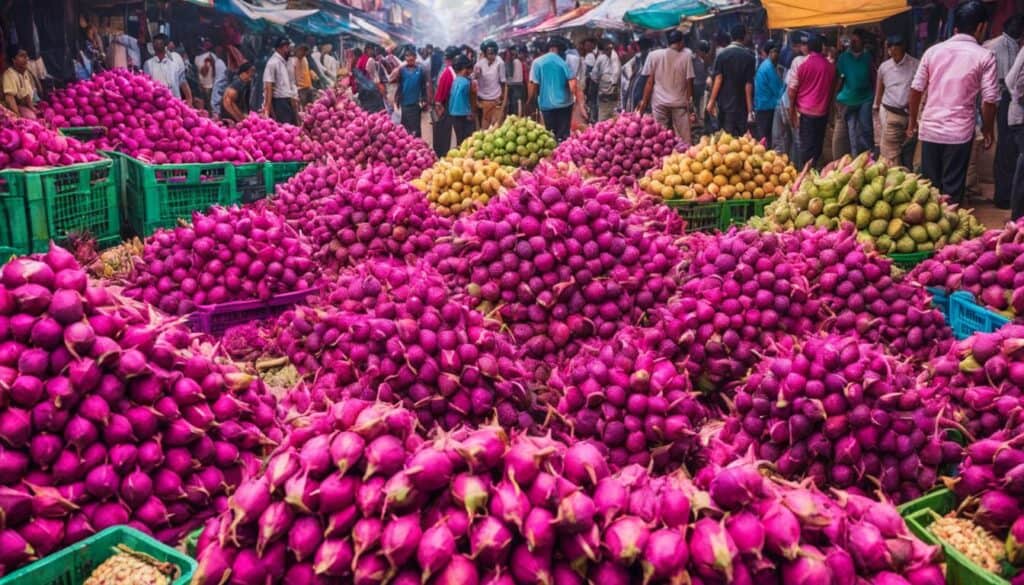
While dragon fruit’s market value may differ between regions, its popularity and consumption trends remain steady. Its appeal lies not only in its aesthetics but also in its reputation as a trendy and fashionable fruit.
Stay tuned to discover more captivating insights about dragon fruit’s allure and unique characteristics in the upcoming sections.
Dragon Fruit’s Allure and Unique Characteristics
Dragon fruit’s magical appearance and unique characteristics make it a captivating fruit that stands out among others. Its bright pink color and flame-like tendrils give it an exotic and visually appealing look, making it a popular choice for design themes and even as a rare item in video games.
However, while dragon fruit may be visually stunning, it falls short in terms of taste. The fruit’s lack of flavor and mild taste undermine its value as a delicious snack. Dragon fruit is often described as bland and lacking in any distinct flavor profiles.
Although dragon fruit may not satisfy the taste buds, its aesthetic qualities make it a great addition to decorative displays and fruit platters. Its unique appearance can enhance the visual appeal of various food and beverage presentations, adding a touch of elegance and sophistication.
Despite its lackluster taste, dragon fruit still holds a special allure, captivating people with its vibrant color and distinct characteristics. Its magical appearance continues to attract attention and intrigue, making it a favorite among those who appreciate its aesthetic value.
| Dragon Fruit’s Allure and Unique Characteristics | |
|---|---|
| Appearance | Magical and visually appealing with a bright pink color and flame-like tendrils. |
| Aesthetics | Popular in design themes and as a rare item in video games. |
| Snack Value | Underwhelming taste that lacks flavor, but visually stunning. |
Conclusion
After exploring the world of dragon fruit, it’s clear that while this fruit may not satisfy our taste buds, it still holds a significant place in the market. Despite its underwhelming flavor and lack of aroma, dragon fruit’s impressive size and appearance continue to captivate consumers around the world.
Dragon fruit plays a crucial role in Vietnam’s fruit export plans, contributing to the country’s recognition in the agricultural industry. Its popularity has also led to global expansion, with farmers in various countries, including Kenya, venturing into dragon fruit cultivation. However, this expansion presents challenges, such as over-production and volatile market prices.
While dragon fruit may not be the most delicious fruit out there, its allure lies in its unique characteristics and visual appeal. Its bright pink color and flame-like tendrils make it a striking addition to design themes and a coveted item in video games. So, while dragon fruit may not excite our taste buds, it continues to captivate us in other ways.
FAQ
Is the dragon fruit sculpture in Malaysia officially recognized as the largest in the world?
Yes, the Malaysian Book of Records has awarded the title of the largest dragon fruit-shaped structure in the world to the creation in Malaysia.
What are the new dragon fruit varieties developed through collaboration between New Zealand and Vietnam?
The new dragon fruit varieties are red-skinned, sweeter, and more aromatic than current varieties. They also have canker tolerance, which is a significant breakthrough in dragon fruit breeding.
Which country is the largest dragon fruit supplier in the world?
Vietnam is the largest dragon fruit supplier in the world, producing around 1 million tonnes of dragon fruit annually.
Where is dragon fruit native to?
Dragon fruit, also known as pitaya, is native to Central and South America.
What is the main region for dragon fruit cultivation in Vietnam?
Binh Thuan province is the main region for dragon fruit cultivation in Vietnam, accounting for approximately three-quarters of the nation’s production.
How did the COVID-19 pandemic impact the dragon fruit industry?
The COVID-19 pandemic led to challenges for the dragon fruit industry, particularly due to heavy reliance on the Chinese market. When China shut down its borders, dragon fruit crops began to rot, causing significant losses for farmers.
Is dragon fruit gaining popularity globally?
Yes, dragon fruit is gaining popularity in various markets, including America, where it is considered a trendy fruit. It is used in various beverages and high-end cocktails.
What is the taste of dragon fruit like?
Dragon fruit is often described as bland and lacking in flavor. Some even compare its taste to walking the wrong way on an escalator in an empty shopping mall.
Does dragon fruit have market value?
Yes, dragon fruit has market value, particularly in Vietnam where it is an important commodity for fruit exports. It contributes to the country’s agricultural recognition and export plans.
How is dragon fruit used in the global market?
Dragon fruit is used in various food and drink items and has gained popularity in design themes and video games due to its magical appearance.
What are the unique characteristics of dragon fruit?
Dragon fruit’s unique characteristics include its bright pink color and flame-like tendrils, making it visually appealing. However, its lack of taste undermines its value as a tasty snack.

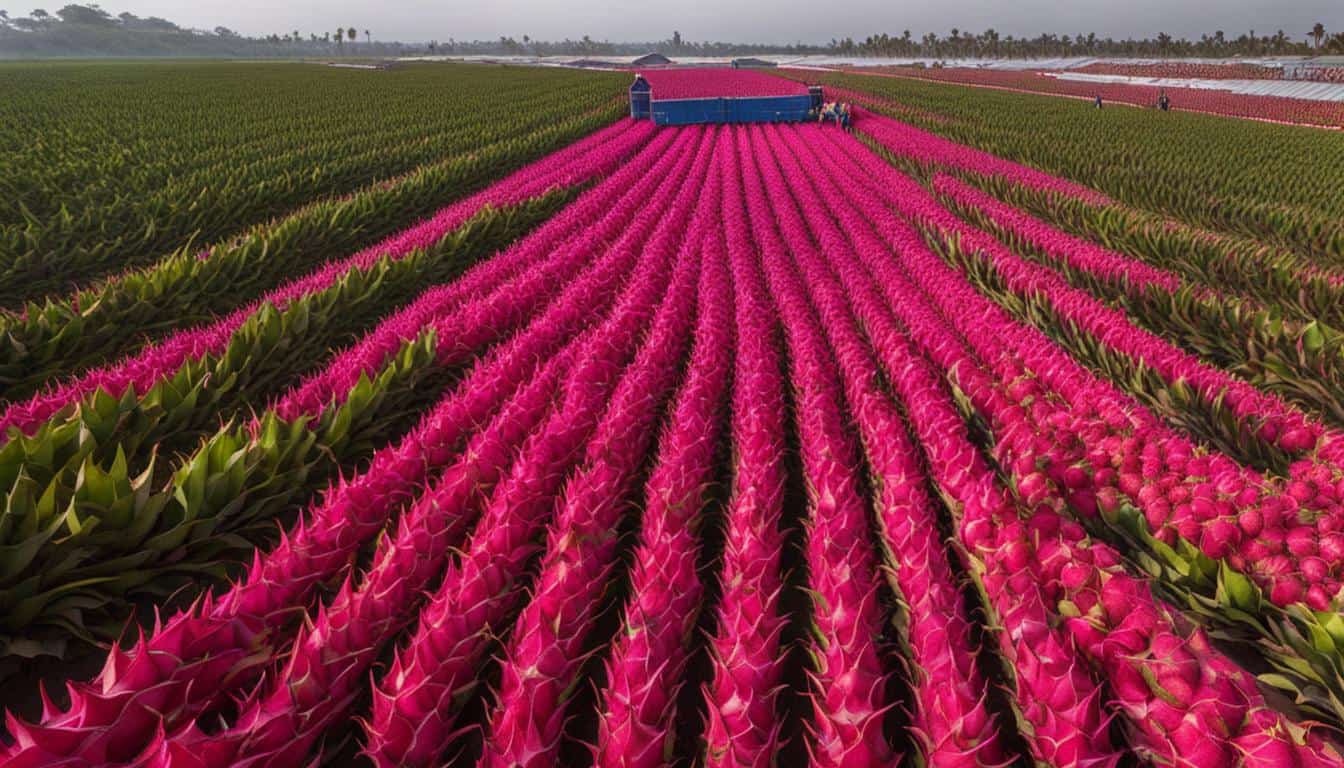



Leave a Reply